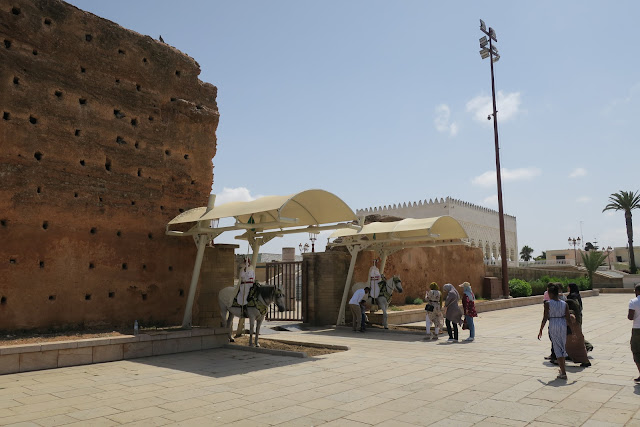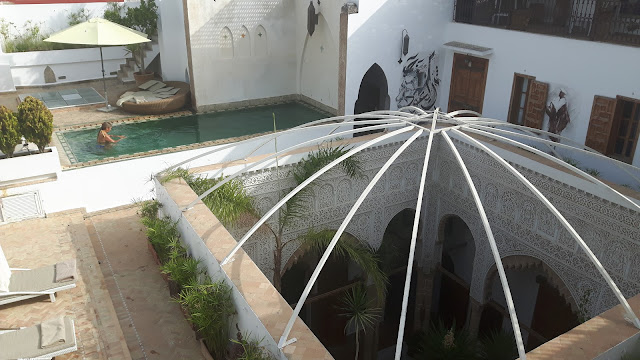I met a traveller from an antique land,
Who said—“Two vast and trunkless legs of stone
Stand in the desert. . . . Near them, on the sand,
Half sunk a shattered visage lies, whose frown,
And wrinkled lip, and sneer of cold command,
Tell that its sculptor well those passions read
Which yet survive, stamped on these lifeless things,
The hand that mocked them, and the heart that fed;
And on the pedestal, these words appear:
My name is Ozymandias King of Kings;
Look on my Works, ye Mighty, and despair!
Nothing beside remains. Round the decay
Of that colossal Wreck, boundless and bare
The lone and level sands stretch far away.”
I don't know why, but the words of Shelley were in my head when we went to see the great unfinished Mosque and the Hassan Tower begun by Yacoub El-Mansour in about 1196.
It is also the site of the Mausoleum of Mohammed V.
Guarded at every juncture by uniformed and armed soldiers. The entrance mounted troops are at least provided with shade.
The Mausoleum and New Mosque are certainly impressive, in glorious white Italian marble. Of course as non Muslims we are not allowed in the Mosque. The actual Mausoleum is the square building with the green roof on the left in the photo above.
Immediately in front are the remains of the unfinished mosque, built to be the second largest in the Muslim world at the time, Not forgetting this was 1196. The Hassan Tower is the unfinished minaret and the many pillars delineate the prayer floor. This would have been 600feet by 456 feet square and the minaret would have been 262 feet high. As it stands today at 144feet high its still impressive.
I stood and imagined the scale of the roof over this prayer floor and then remembered that the unfinished building was destroyed by the same earthquake that flattened Lisbon in 1755.
Shelly got it right......
Lynne is standing in front of the several entrances to the Mosque, I think the one immediately to her left is the women's entrance.
Its difficult to know where to look sometimes, do I admire the modern resting place of a direct descendant of Mohammed, or the fantastic vision of a person almost forgotten by history?
I suppose you can and should do both. The resting place of Mohammed V, who after all is the father of Moroccan independence was commissioned by his son Hassan II. Strangely it was designed by a Vietnamese architect, Vo Tuan.
Like a lot of Muslim architecture as despite the architects nationality it is decidedly Muslim, it pays to examine the detail. I think it was a scientist who said that god is in the detail. The intricate carving has to be seen to be fully appreciated it simply drags you in, as in nature the closer you look there always seems to be more to see.
There is no getting away from the fact that this is a simply stunning building and available to Christians and atheists alike. The black marble floor reflects the ceiling lights and the sarcophagus is carved from a singe block of marble.
Here is a snippet of video of the interior.
Outside it was back to the baking sun. We walked across the extensive maze of 26 rows of pillars towards the Hassan Tower and were a bit surprised to find some sunken fountains (and another soldier on guard)
There are obviously other openings which I assume are the museum which we think is actually not open yet. Not unusual for Morocco...…
From a little way further its possible to glimpse the marina in Salé where we would have berthed Dark tarn if we had got this far south.
As it was we were content to be tourists for a change and admire the Hassan Tower and wonder at the strange noises coming out of it. We think birds...…
We could also look back on the Medina where we were staying and both Lynne and I at ths point were thinking , how nice to go for a swim in the rooftop pool.....
The fountains had also turned on making us appreciate the cool water.
We left the tower and its mudstone walls behind and headed back into the medina.
I managed to buy a real leather belt for a couple of quid so that was all good, and my trousers would no longer be falling down! The many shopping streets in the medina are a real assault on your senses. However Rabat is not as intimidating as some and the streets particularly the Rue souk and Rue des consuls are fascinating to walk along, there are artisans and craftsmen, leatherworkers and spice merchants. Much as it has probably always been.
Later we decided to dine in the Hotel and enjoyed a bottle of wine, The previous evening I had ordered a tagine of lamb with figs and raisins that Lynne had been tasting all day, so guess what she ordered …..
A great day exploring …..





















































